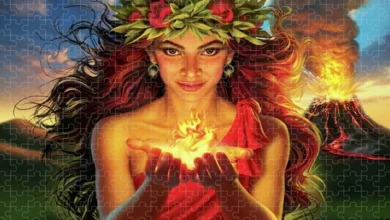“Bathing is forbidden”: Do Himba men offer wife to visitors?
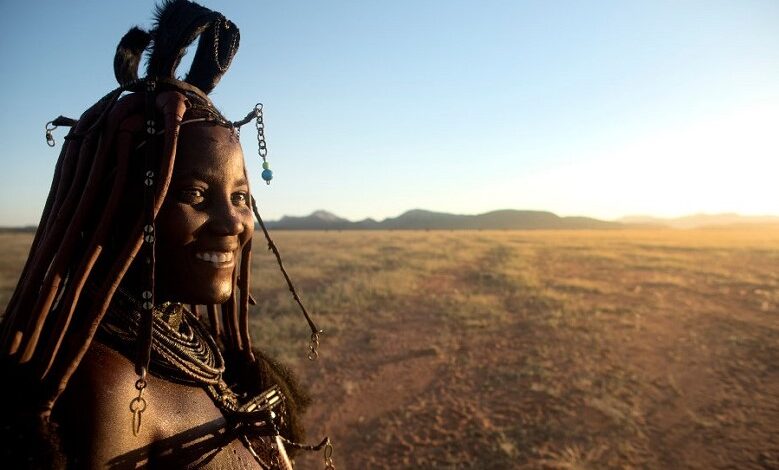
No taking of bath or offering wife to his visitors? Some tribes, such as the Himba, still respect and live according to their ancestors’ traditions throughout Africa. The proud but friendly Himba are famous for their unusual sculptural beauty, enhanced by sophisticated hairstyles and jewellery.
Initially sharing ethnicity with the Herero group, the Himba dated back to Botswana and Namibia’s dominant group. The Himba looked west for more available land – they found the Kunene region (formerly Kaokoland), which is very drought and mountainous with very little vegetation.
Still, it was there that they were in more remote and isolated areas with their cattle. Today, about 50,000 Himba live in northern Namibia (less than 1/2 per cent of the country’s population).
Lifestyles of Himba
Traditional Economy
They are semi-nomadic pastoralists who raise cattle and breed goats, fat-tailed sheep and focus on maize and millet crops. This agriculture provides their milk, meat as the mainstay of their diet, supplemented by cornmeal, maize, chicken, eggs, honey and wild herbs.
Only a small part of their livelihood comprises non-farm enterprises and is made possible through their water work, pensions and relief assistance from the Namibian authorities.
Everyday life
Men are allowed to stay away from the village for long periods during grazing, taking care of livestock. They are also responsible for slaughtering animals and building. They also handle political tasks and legal trials.
Women tend to do more labour-intensive work than men, such as carrying water to villages, building houses with red clay soil, making jewellery and clothing. They are responsible for and milking cows and goats and looking after their offspring.
According to the Guardian, when a visitor knocks, the man expresses his approval and pleasure to see his guest by giving him the Okujepisa Omukazenda treatment – the wife gives herself to his guest to spend the night. At the same time, her husband sleeps in another room. In case there is no spare room, her husband will sleep outside. This strengthens the relationship and reduces jealousy.
However, the tradition that stood the test of time is the “bathing is forbidden”. To overcome the issues of no bathing, these women know for rubbing their bodies with otjize, a mixture of cream and ochre believed to use them to guide their skin from the harsh weather. The red combination symbolizes the rich red colour of the earth and the blood that represents life.
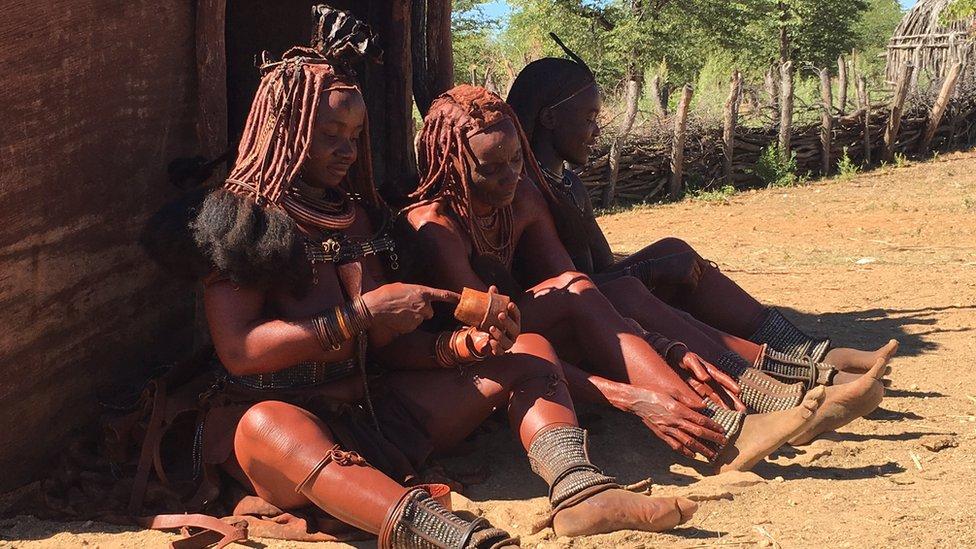
Their homes are simple, conical structures of saplings, combined with palm leaves, mud and dung.
Himba Religion and Beliefs
Himba devotes themselves to their ancestors and the god Mukuru. Usually, since Mukuru is busy in distant realms, the ancestors act as representatives of Mukuru.
Himba retains their traditional beliefs, including ancestor worship and rituals about okoruwa (sacred flames), which is considered an essential link between the living and the dead. Each settlement has an okoruwo, which always located between the kraal ( village) entrance and the main house’s door. Used to light all flames in the territory, and it is the responsibility of the most senior members of the patriclan to ensure that it stays shade lit and never goes out.
The Okoruwo fire is used for daily rituals and special ceremonies such as birth, death, marriage, and tradition; through this medium, communication with the ancestors’ spirits occurs.
Himba tribal marriage
Their men can have two wives. Arranged marriages are typical for a young girl’s father to choose his daughter’s partner – usually around age 13 or during puberty. Boys circumcised before puberty – this is considered a rite of passage for men.
Himba boy becomes a man as soon as he is married, but a Himba girl not considered a woman until she has passed through childbearing.
Clothing
Men and women wear traditional clothing suitable for the hot, semi-arid climate of Kaokoland: it generally consists of simple calfskin skirt type garments (although modern fabrics which are mainly used. Their sandals have soles and usually made of old car tires.
Hairstyle
In Himba, hairstyles are used to indicate age and social status.

Single men wear a braided braid at the back of their head. The married men wear a head wrap or cap with unfastened hair underneath. If a man is widowed, he wears his hair without a hat, without a cap.
Women married for a single year, or if she has a child, she will wear an Erembe – a sheepskin headdress, which is gorgeous woven coloured hair shapes with otjize paste.
Postpubertal boys have one braided braid; girls tend to have many textured hair braids or otjize, often forming a veil over the face, although, as a matter of course, these braids tied together away from the girl’s face.
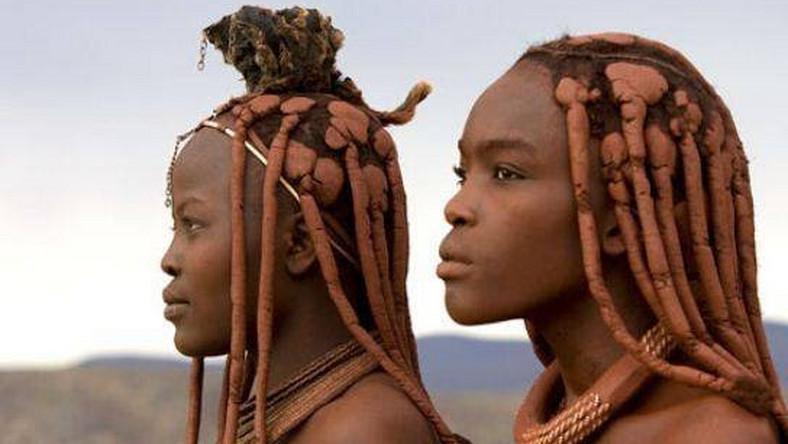
Children usually have shaved heads, except for a small part on the top, often braided at the back for young boys; girls have two braids pulled forward at the front. Young girls, who are one pair of twins, may also have one braided braid pulled ahead.
They use wood ash to clean their head because of the scarcity of water.
Traditional jewellery of Himba
Today the Himba adorn themselves with traditional jewellery according to ancient customs.
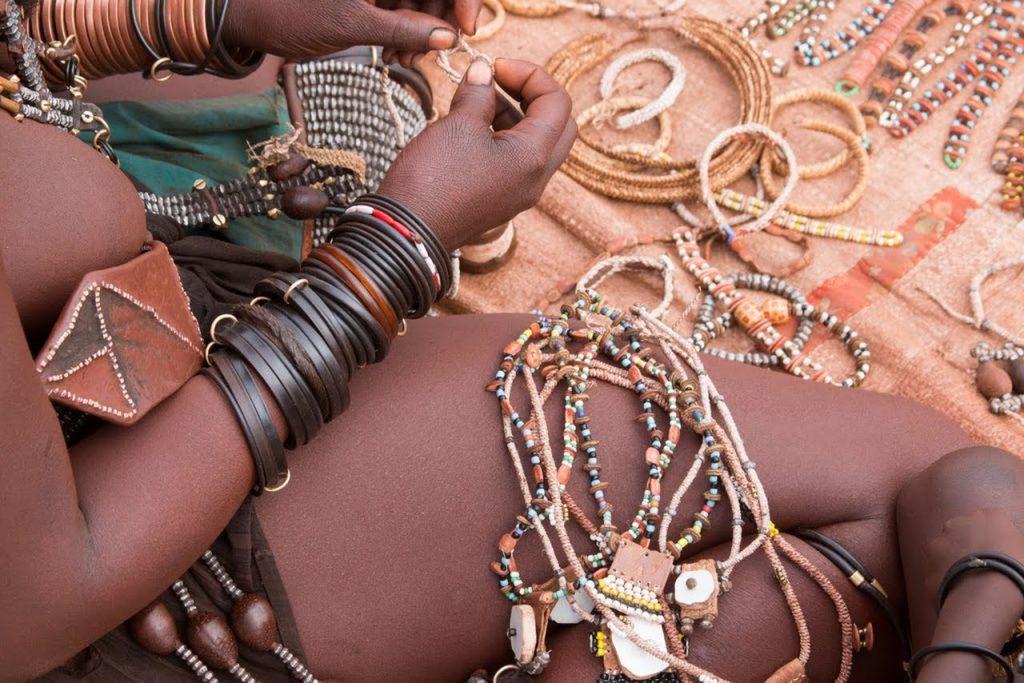
Both men and women wear many necklaces, bracelets on their arms, sometimes almost like sleeves, made of beads from ostrich eggshells, grass, cloth and copper and weighing up to 40 kg, as well as bracelets around their legs, with its lustrous effect, iron oxide powder worn as a cosmetic, similar to Western glitter.
Adult women wear beaded leg bracelets, apparently to protect their legs from venomous animal bites. The large white shell worn on the Himba’s chest (and Owambo and Herero women) is called Ohumba.
Himba tribe food
The Himba people adhere to porridge.

They heat some water morning and evening, wait for it to boil, and put some flour in it, maybe add some oil, and the meal served. The flour is mostly corn, but from time to time, you can find some Mahangu flour. Mahangu is another name for pearl millet; it is a common crop in Namibia because it works well on soils with low fertility. On rare occasions, such as weddings, the Himba eat meat, which is the exception rather than the rule.

